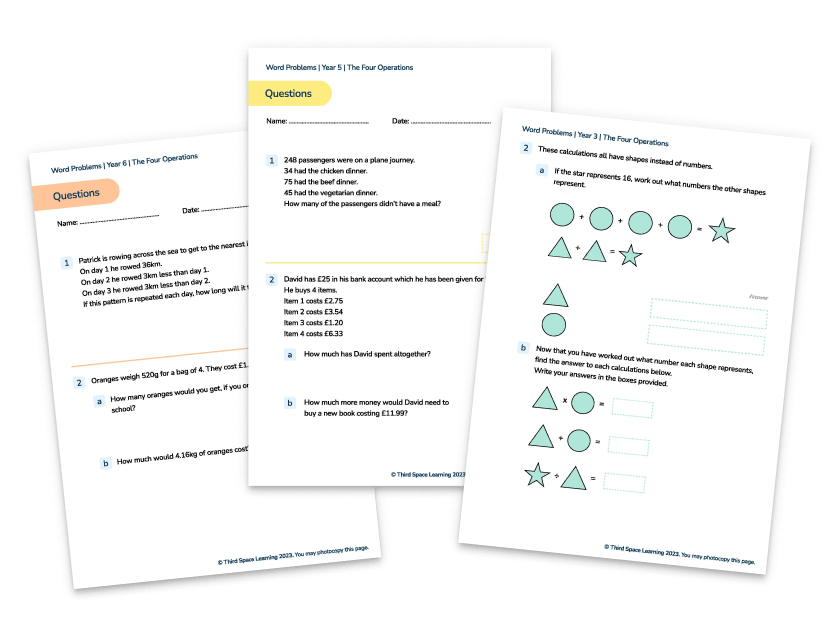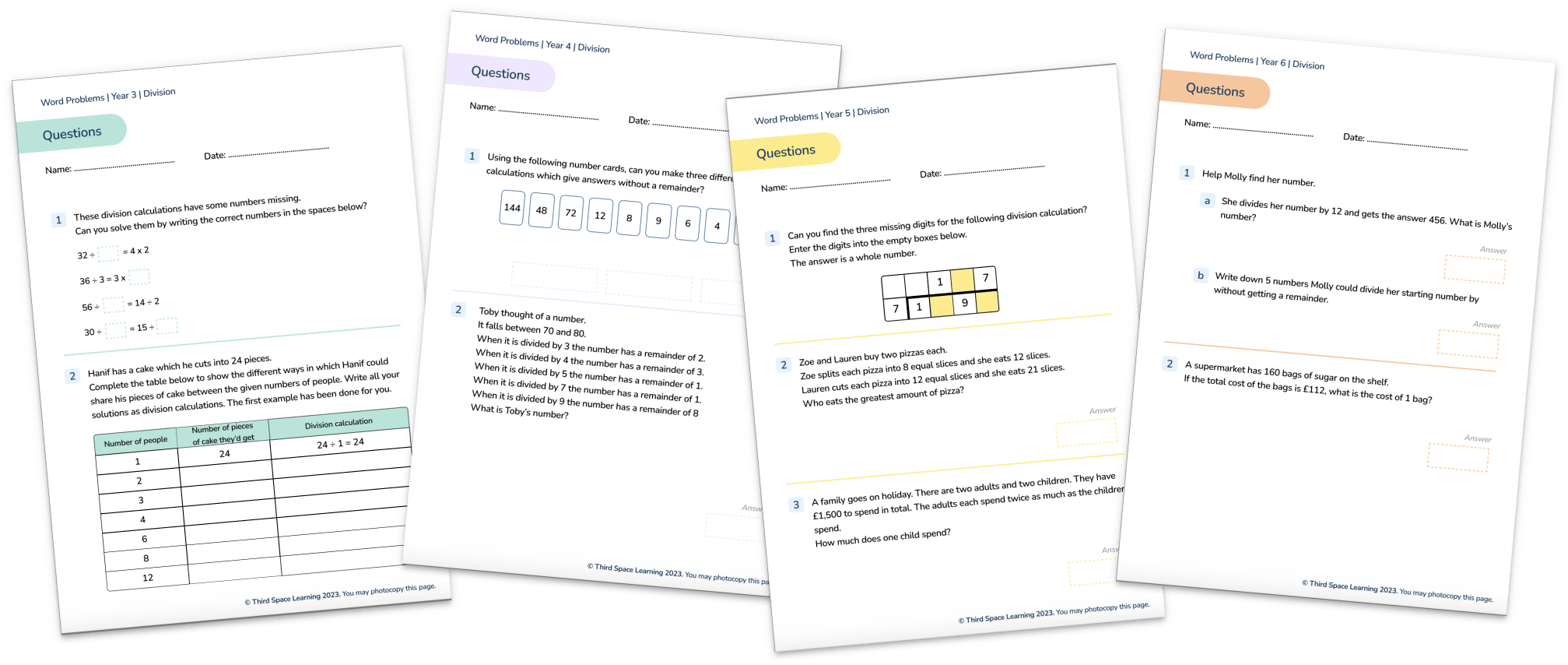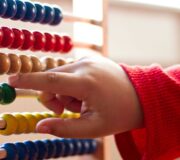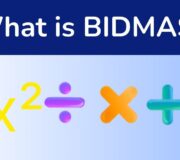What Is Division? Explained For Primary School
What is division? There are four basic operations in maths: addition, subtraction, multiplication and division. Children will encounter all of these at primary school, starting from Year 1. From experience, children tend to find division the trickiest to grasp.
What is division?
Division is a mathematical operation which involves the sharing of an amount into equal-sized groups. For example, “12 divided by 4” means “12 shared into 4 equal groups”, which would be 3.
In mathematics, this is written with the division symbol, called an obelus → ÷. Division can also be presented as a fraction: in this case, 12/4 (the division sign is represented as a forwards slash) or 124 (the division sign here is represented as a horizontal line). 12 ÷ 4, 12/4 and 124 are all equal to 3.
In a division, the first number (the amount being divided) is called the dividend; the second number (whatever the dividend is being divided by), is called the divisor; the answer is called the quotient. So, in the example above, 12 is the dividend, 4 is the divisor and 3 is the quotient.
All Kinds of Word Problems Division
Practice solving word problems and using division with this free, printable worksheet!
Download Free Now!Remainders
Sometimes a number cannot be shared into equal groups with an integer (whole number) as an answer, so we are left with a remainder. Take 13 ÷ 4 – we cannot split 13 equally into 4 groups (unless we venture into decimal numbers), so we would be left with 4 groups of 3 and 1 left over. In mathematics, this would be written as 3 remainder 1 (or 3r1), so 13 ÷ 4 = 3r1. Learn more about division with remainders here.

Unlimited primary maths tutoring with Skye, the voice-based AI maths tutor.
Built on the same principles, pedagogy and curriculum as our traditional tutoring, but with more flexibility, reach and lower cost.
Join the schools already helping hundreds of primary pupils nationwide with Skye’s one to one maths tutoring.
Watch Skye in actionDivision and its inverse: multiplication
Division is often referred to as the opposite of multiplication. In the example 12 ÷ 4 = 3, we can use the inverse to see that 3 x 4 = 12. Likewise, where 12 ÷ 3 = 4, the inverse is that 4 x 3 = 12.
Whilst “dividing by 4” is usually seen as “sharing into 4 equal groups”, it could also be seen as “how many equal shares of 4 can be made?”. Despite the similar wording, there is a distinct difference between the two. See the first example below of 12 ÷ 4 – this shows 12 being shared into 4 equal groups (with 3 in each group). In the second example of 12 ÷ 4, it shows how many equal groups of 4 can be made – which is 3. Ultimately, the answers (quotients) are the same!

Division facts
If a number is divisible (which means it can be divided by) by a one-digit number with no remainder (the quotients in these examples would be called factors), there is often a quick way to tell without having to actually work it out! A number is…
- …divisible by 2 if it is even (i.e. ends in one of the following digits: 0, 2, 4, 6 or 8)
e.g. 746 is divisible by 2 (can be divided by 2 without a remainder, or has 2 as a factor) - …divisible by 3 if the sum of the digits is a multiple of 3
e.g. 471 is divisible by 3 because 4 + 7 + 1 = 12 and 1 + 2 = 3, which is a multiple of 3 - …divisible by 4 if the last 2 digits make a multiple of 4
e.g. 7,324 is divisible by 4 because 24 is a multiple of 4 – this works because subtracting the last two digits leaves you with a multiple of 100, and every multiple of 100 is also a multiple of 4 - …divisible by 5 if the last digit is a 0 or 5
e.g. 285 is divisible by 5 - …divisible by 6 if the number is divisible by both 2 and 3 (see rules above)
e.g. 438 is divisible by 6 because it’s even and its digit sum is a multiple of 3 (4 + 3 + 8 = 15, 1 + 5 = 6) - …divisible by 8 if the last 3 digits make a multiple of 8 (so this will require a bit more working out!)
e.g. 42,976 is divisible by 8 because 976 is a multiple of 8 (978 ÷ 8 = 122) – this works because subtracting the last three digits leaves you with a multiple of 1,000, and every multiple of 1,000 is also a multiple of 8 - …divisible by 9 if the sum of the digits is a multiple of 9
e.g. 7,281 is divisible by 9 because 7 + 2 + 8 + 1 = 18 and 1 + 8 = 9 - …divisible by 10 if the last digit is a 0
e.g. 91,420 is divisible by 10
How to explain division
To introduce division, start with smaller numbers and the concept of sharing in equal groups, e.g. my friend and I have 6 sweets and we want to share them between us – how many do we each get? By taking one sweet, giving one to my friend, taking another, giving another to my friend, taking one more and giving the last one to my friend, we can easily see we’d have 3 each.
As well as the concept of sharing, we can talk about grouping when we discuss division. In the problem above, instead of thinking about sharing between 2 people, we would talk about groups of 2 – how many groups of 2 can be made? By pairing up the sweets, we can make 3 groups.
Grouping and sharing are two ways of discussing division (as also previously referred to for 12 ÷ 4). However, there are other ways, such as repeated subtraction and using more formal methods (particularly useful as children move onto larger numbers) – see how to teach division for more support for whole classroom teaching and our division intervention blog to target individual pupils.
When do children learn about division in school?
Children learn the concept of division right from Year 1, but the formal method of division (commonly known as the bus stop method) isn’t introduced until Year 5, where the children begin with short division (usually used when dividing by a one-digit number).
They will then learn long division (usually used when dividing by a 2-digit number) in Year 6. The long division method can be tricky for students, so make sure you see our long division examples and long division questions to support your teaching in the classroom.
| Year | Statutory requirements |
| 1 | solve one-step problems involving multiplication and division, by calculating the answer using concrete objects, pictorial representations and arrays with the support of the teacher recognise, find and name a half as one of two equal parts of an object, shape or quantity recognise, find and name a quarter as one of four equal parts of an object, shape or quantity |
| 2 | recall and use multiplication and division facts for the 2, 5 and 10 multiplication tables, including recognising odd and even numbers, calculate mathematical statements for multiplication and division within the multiplication tables and write them using the multiplication (×), division (÷) and equals (=) signs, show that multiplication of two numbers can be done in any order (commutative) and division of one number by another cannot, solve problems involving multiplication and division, using materials, arrays, repeated addition, mental methods, and multiplication and division facts, including problems in contexts |
| 3 | recall and use multiplication and division facts for the 3, 4 and 8 multiplication tables, write and calculate mathematical statements for multiplication and division using the multiplication tables that they know, including for two-digit numbers times one-digit numbers, using mental and progressing to formal written methods, solve problems, including missing number problems, involving multiplication and division, count up and down in tenths; recognise that tenths arise from dividing an object into 10 equal parts and in dividing one-digit numbers or quantities by 10 |
| 4 | recall multiplication facts and division facts for multiplication tables up to 12 × 12 use place value, known and derived facts to multiply and divide mentally, including: multiplying by 0 and 1; dividing by 1; multiplying together three numbers, count up and down in hundredths; recognise that hundredths arise when dividing an object by one hundred and dividing tenths by ten, solve problems involving increasingly harder fractions to calculate quantities, and fractions to divide quantities |
| 5 | multiply and divide numbers mentally drawing upon known facts, divide numbers up to 4 digits by a one-digit number using the formal written method of short division and interpret remainders appropriately for the context, multiply and divide decimals and whole numbers 10, 100 and 1000solve problems involving multiplication and division including using their knowledge of factors and multiples, squares and cubes, solve problems involving addition, subtraction, multiplication and division and a combination of these, including understanding the meaning of the equals sign, solve problems involving multiplication and division, including scaling by simple fractions and problems involving simple rates |
| 6 | divide numbers up to 4 digits by a two-digit whole number using the formal written method of long division, and interpret remainders as whole number remainders, fractions, or by rounding, as appropriate for the context, divide numbers up to 4 digits by a two-digit number using the formal written method of short division where appropriate, interpreting remainders according to the context, perform mental calculations, including with mixed operations and large numbers, solve problems involving addition, subtraction, multiplication and division, divide proper fractions by whole numbers, associate a fraction with division and calculate decimal fraction equivalents for a simple fraction, use written division methods in cases where the answer has up to two decimal places |
How does division relate to other areas of maths?
As mentioned frequently throughout the curriculum, children are required to know their times tables and related division facts before the end of Year 4. However, another key part of the maths curriculum – introduced right from Year 1 – is fractions. A fraction is, essentially, a division.
Take one-half (½) for example: this literally means 1 ÷ 2; one shared into two equal groups is ½ (or 0.5). Here, the numerator (top number of the fraction) is the dividend; the denominator (bottom number of the fraction) is the divisor, and the fraction itself is the quotient!
As another example, look at three-eights (⅜): 3 ÷ 8, or three shared into eight equal groups, is ⅜ (or 0.375).
In order to understand fractions, children must fully understand the process of dividing – at first by 2 and 4 (as Year 1s are expected to find 1/2s and 1/4s of objects, shapes and quantities); then by 5 and 10 (Year 2); then 3, 4 and 8 (Year 3); then by 1, 6, 7, 9, 11 and 12 (Year 4); then by any one-digit number (Year 5); and finally by any two-digit number (Year 6).
How does division link to real life?
Division is required whenever something needs to be shared equally between two or more groups. This could be cost (e.g. a £174 bill between four people), distance (e.g. working out the halfway point between two destinations), weight (a 2kg bag of apples shared three ways) or much more!
It is important to convey to students how division plays into everyday life. At Third Space Learning we try to incorporate real world division problems into our one-to-one online maths lessons. Personalised to each student’s unique needs, our online tuition aims to fill gaps in maths knowledge. In addition to online tuition, Third Space Learning offers an extensive collection of worksheets, learning and teaching resources to support students and teachers.
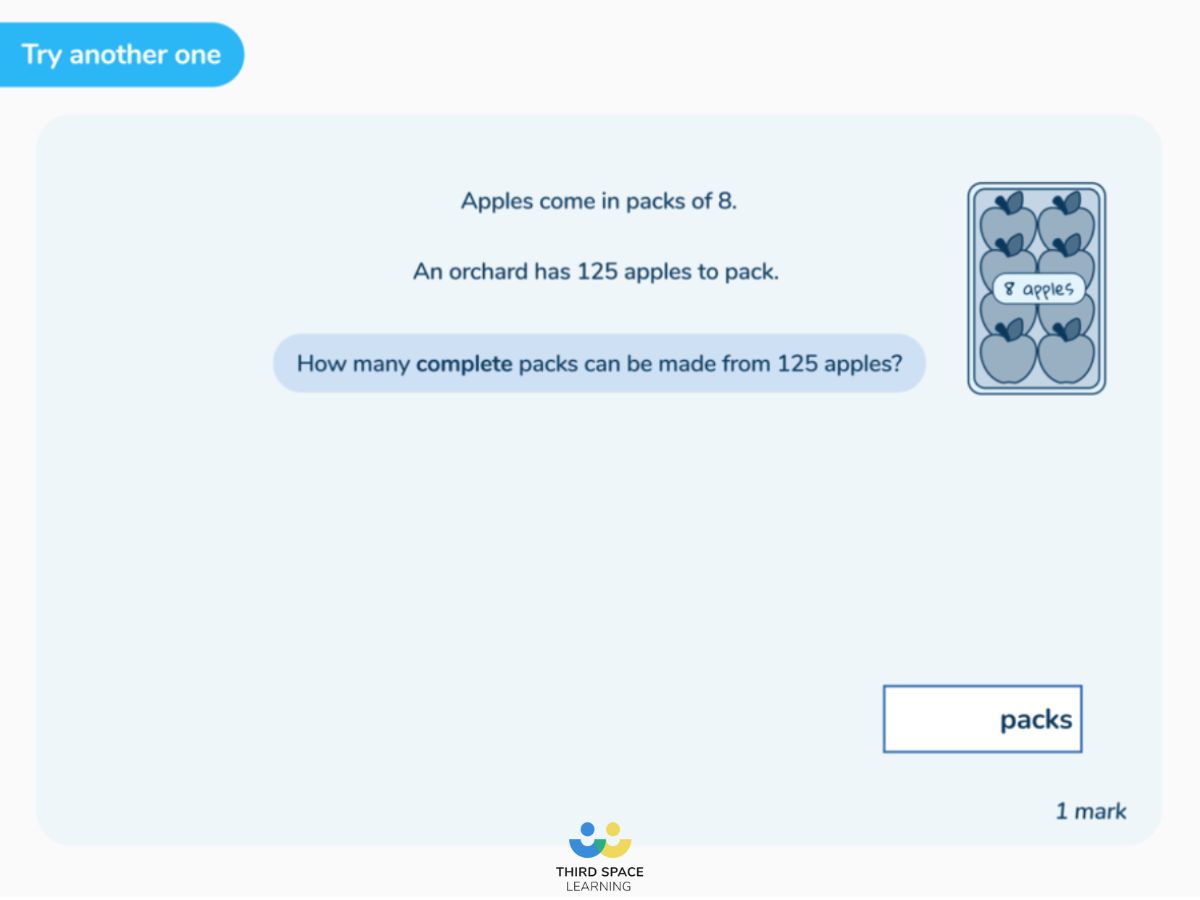
Division worked examples
- There are 10 sweets. Milly and her friend want to share them. How many do they each get?
The division here is 10 ÷ 2. Through the concept of sharing, the diagram below shows 10 sweets shared into 2 groups, resulting in 5 in each group.
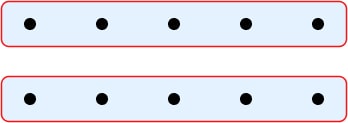
Through the concept of grouping, the diagram below shows 10 sweets grouped in 2s, resulting in 5 groups.
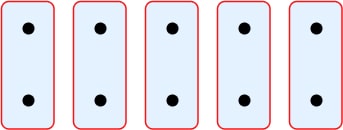
- 65 children take part in a quiz. There are 5 children in each team. How many teams are there altogether?
We could either count up in 5s until we reach 65 (13 times), or use our knowledge that 10 lots of 5 is 50, and we’d need 3 more 5s to make 65, so that is 13 lots of 5. Either way, we’d reach the answer of 13 teams.
- Sam is making booklets. Each booklet must have 34 sheets of paper. He has 2 packets of paper. There are 500 sheets of paper in each packet. How many complete booklets can Sam make from 2 packets of paper?
2 packets x 500 sheets = 1,000 sheets of paper. Using long division, we can calculate that 1,000 ÷ 34 = 29 r 14. Sam can’t make a complete booklet out of 14 sheets, which means that he can only make 29 complete booklets.
Division practice questions
- Kim has 15p. She wants to share it equally between her and her two friends. How much would they each get? Answer: 5p each
- 36 ÷ 4. Answer: 9
- A length of rope measures 224cm. It needs to be cut into 4 equal sections. How long is each section? Answer: 56cm
- 2,464 ÷ 7. Answer: 352
- Eggs are put in trays of 12. The trays are packed in boxes. Each box contains 180 eggs. How many trays are in each box? Answer: 15 trays
There are four properties within division: the dividend, divisor, quotient and remainder.
Division is sharing an amount equally.
Division is used to share an amount equally or to split an amount into equal groups.
Divisibility rules are rules that can help you to know if one whole number is divisible by another whole number. There are a number of divisibility rules.
Read more:
DO YOU HAVE STUDENTS WHO NEED MORE SUPPORT IN MATHS?
Skye – our AI maths tutor built by teachers – gives students personalised one-to-one lessons that address learning gaps and build confidence.
Since 2013 we’ve taught over 2 million hours of maths lessons to more than 170,000 students to help them become fluent, able mathematicians.
Explore our AI maths tutoring or find out about online maths tuition for your school.
